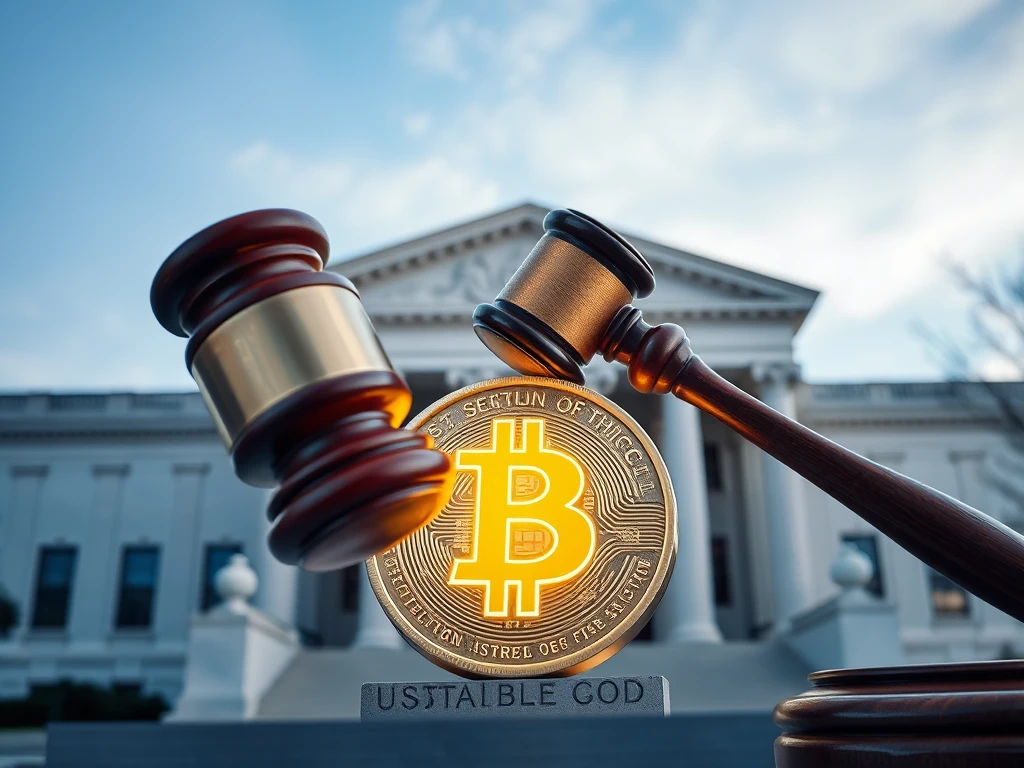Bold SEC Stablecoin Guidelines Exclude Algorithmic Tokens: What’s Next?

The world of stablecoins, a cornerstone of the crypto market valued at over $228 billion, just got a significant regulatory shake-up. The United States Securities and Exchange Commission (SEC) has dropped its much-anticipated guidelines for stablecoins, and the implications are huge. If you’re invested in or following the crypto space, especially stablecoins, pay close attention – this could redefine the landscape.
Decoding the SEC’s Stablecoin Guidelines: What You Need to Know
In a statement released on April 4th, the SEC unveiled its framework for regulating stablecoins, introducing the term “covered stablecoins.” This new classification is crucial because it essentially carves out a regulatory safe harbor for certain types of stablecoins, while leaving others in a state of uncertainty. Let’s break down the key elements of these SEC guidelines:
- Definition of ‘Covered Stablecoins’: The SEC defines a “covered stablecoin” as one that is:
- Fully Backed: Reserves must be held in physical fiat currency or short-term, low-risk, and highly liquid instruments.
- 1:1 Redeemable: Token holders must be able to redeem their stablecoins for US dollars at a 1:1 ratio.
- Exemption from Reporting: Transactions involving “covered stablecoins” are exempt from certain reporting requirements, simplifying compliance for issuers of these specific stablecoins.
- Exclusion of Algorithmic Tokens: Crucially, the SEC’s definition explicitly excludes algorithmic stablecoins. These tokens, which rely on software and automated trading strategies to maintain their peg, do not meet the criteria for “covered stablecoins.”
- Restrictions on Issuers: Issuers of “covered stablecoins” face strict limitations:
- No Co-mingling of Funds: Reserves cannot be mixed with operational capital.
- No Yield or Interest: Issuers are prohibited from offering interest, profit, or yield opportunities to token holders.
- No Speculation: Reserves cannot be used for investments or market speculation.
In essence, the SEC is drawing a clear line in the sand. Stablecoins that adhere to traditional reserve models and prioritize stability are being given a path towards regulatory clarity, while those employing more novel, algorithmic approaches are left in a regulatory gray area. This move reflects a cautious approach, prioritizing investor protection and market stability over fostering innovation in potentially riskier stablecoin designs.
| Feature | Covered Stablecoins (SEC Definition) | Algorithmic Stablecoins |
|---|---|---|
| Reserve Backing | Fiat Currency or Low-Risk, Liquid Assets | Software, Automated Trading Strategies |
| Regulatory Clarity | Defined Guidelines, Exemptions | Regulatory Status Uncertain |
| Yield Opportunities | Prohibited for Issuers to Offer | Not Directly Addressed by These Guidelines |
| Reserve Usage | Restricted – No Speculation | Not Directly Addressed by These Guidelines |
Why Exclude Algorithmic Stablecoins? The Regulatory Rationale
The exclusion of algorithmic stablecoins from the “covered” category is a deliberate move by the SEC, likely stemming from concerns about their inherent risks and past failures. Algorithmic stablecoins, unlike their fiat-backed counterparts, rely on complex mechanisms to maintain their peg. These mechanisms can be vulnerable to market volatility and ‘bank runs,’ as demonstrated by the collapse of TerraUSD (UST) and its associated LUNA token in 2022, which sent shockwaves through the crypto industry.
The SEC’s caution is understandable given its mandate to protect investors and maintain market integrity. Algorithmic stablecoins, while potentially innovative, present a greater degree of complexity and risk compared to traditional, reserve-backed stablecoins. By focusing on “covered stablecoins,” the SEC is prioritizing a more conservative and, arguably, safer approach to stablecoin regulation.
Broader US Policy Alignment: Protecting the Dollar’s Dominance
Interestingly, the SEC’s definition of “covered stablecoins” aligns with broader US policy objectives, particularly the desire to safeguard the US dollar’s status as the global reserve currency. This alignment is evident in proposed legislation like the GENIUS Stablecoin Bill and the Stable Act of 2025. These legislative efforts, along with the SEC guidelines, aim to promote stablecoins that are firmly anchored to the US dollar and US government securities.
The strategy is clear: by regulating and legitimizing fiat-backed stablecoins, the US can strengthen demand for US dollars and US government debt. This point was underscored by US Treasury Secretary Scott Bessent at the White House Digital Asset Summit, where he stated the US intends to use stablecoins to extend US dollar dominance. The fact that Tether, the largest stablecoin issuer, is now a major holder of US Treasuries, surpassing nations like Canada and Germany, further illustrates this point.
The Future of Stablecoin Regulation and Innovation
While the SEC guidelines provide much-needed clarity for fiat-backed stablecoins, they also raise questions about the future of algorithmic stablecoins, synthetic dollars, and yield-bearing fiat tokens. The regulatory status of these digital assets remains uncertain, potentially hindering innovation in these areas. Industry leaders are actively advocating for regulatory changes that would allow stablecoin issuers to offer yield opportunities, but the SEC’s current stance suggests a cautious approach will prevail, at least for the near future.
The SEC’s move is a pivotal moment for the stablecoin market. It signals a clear preference for stability and traditional financial principles, while placing algorithmic innovation under a regulatory microscope. Whether this approach will stifle innovation or create a more robust and sustainable stablecoin ecosystem remains to be seen. One thing is certain: the regulatory landscape for digital assets is evolving rapidly, and staying informed is more crucial than ever.
Key Takeaways:
- The SEC has defined “covered stablecoins” and established guidelines for their regulation.
- Algorithmic stablecoins are explicitly excluded from the “covered” category, facing regulatory uncertainty.
- SEC guidelines align with US policy to protect the dollar’s global reserve status.
- Issuers of “covered stablecoins” face restrictions on reserve usage and yield offerings.
- The future regulatory path for algorithmic and yield-bearing stablecoins remains unclear.
Stay tuned for further developments in stablecoin regulation as the crypto industry navigates this evolving landscape. The regulation of these vital digital assets will undoubtedly shape the future of finance and the role of cryptocurrencies in the global economy.









